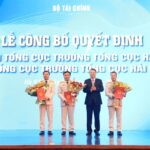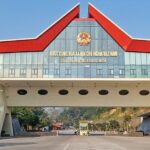The annual Customs – Enterprise Forum in 2024 informed that, in the first eight months of 2024, state budget revenue from import and export activities grew positively,
Total import and export turnover of goods in the first eight months reached US$511.11 billion, up 16.7% over the same period last year. Of which, export turnover reached US$265 billion, up 16%, and import turnover reached US$246 billion, up 18%.
Vietnam’s trade balance surplus was over US$19 billion, 4.1% lower than the surplus of US$19.9 billion in the same period last year.
However, state budget revenue from import and export activities in the period reached VND274,035 billion, up 13.1% over the same period last year.
On the business side, it is recorded that more than 50% of enterprises are satisfied with the information from the Customs. Although the reform activities of the Customs sector have had positive changes, enterprises continue to propose many issues.

6 PROPOSALS FROM THE ‘BRAND NAME KING’
Mr. Johnathan Hanh Nguyen, Chairman of ITPC Group, said: “There is a need to further simplify customs procedures. Standardizing procedures will save time and resources for businesses. At the same time, Customs needs to further improve the World Customs Organization’s (WCO) SAFE Framework of Standards to Secure and Facilitate Global Trade so that we can enter a deeper integration phase with the world economy.”
The scale of the economy’s import and export continues to expand, and this result is largely contributed by the Customs sector. Accordingly, Mr. Johnathan Hanh Nguyen proposed 6 proposals for Customs to support further promoting the import and export scale, including:
+ Further improve the World Customs Organization’s (WCO) SAFE Framework of Standards to Secure and Facilitate Global Trade so that Vietnam can deeply integrate with the world economy.
+ Further simplify procedures to save time and resources for businesses.
+ Strengthen supervision and inspection of anti-trade fraud to protect the interests of legitimate businesses, contributing to a fair, transparent, and stable business environment.
+ Strengthen automation and deploy artificial intelligence (AI).
+ Increase support for small and medium-sized enterprises (SMEs).
+ Study and develop retail policies in free trade zones and duty-free areas, with clear and reasonable retail trade policies, including setting competitive tax-free shopping limits compared to international and regional practices, to promote tourism, attract investment, and improve national competitiveness, keeping up with countries such as China, Korea, and Indonesia, where these policies are being effectively applied.
“THERE IS STILL ROOM FOR IMPROVEMENT IN THE CUSTOMS SECTOR”
According to Mr. Dau Anh Tuan, Vice Secretary General and Head of the VCCI Legal Department: “There is still room for improvement in the customs sector, especially in terms of reducing clearance time for businesses.”
He said that VCCI has cooperated with Customs to measure the actual clearance time of enterprises, showing that although there have been many changes, there is still room for improvement. It is necessary to promote process innovation to make import and export procedures faster and create a compliance incentive for businesses.
From the perspective of the European Business Association in Vietnam (EuroCham), the association expressed its desire for a more efficient and transparent customs system.
According to EuroCham, the implementation of the Vietnam – EU Free Trade Agreement (EVFTA) has marked an important milestone in the economic relations between Vietnam and the EU.
This new and comprehensive FTA has opened up new opportunities for trade, investment, and economic cooperation. EVFTA has reduced tariffs on many products, improved market access for European businesses, and facilitated a dynamic business environment.
Vietnam – EU merchandise trade in 2023 continued to grow thanks to EVFTA. In 2023, the total import and export turnover of goods between Vietnam and the EU region reached US$58.6 billion, accounting for 8.6% of the country’s total trade turnover, of which Vietnam’s exports to the EU reached US$43.68 billion, and imports from the EU reached US$14.9 billion.
He cited the BCI survey, which showed that to maximize the benefits of EVFTA, customs regulations need to be simplified to ensure the smooth flow of goods across borders and efficient compliance.
Integrating technology into customs procedures will be crucial to improving efficiency and transparency.
European businesses are also concerned about compliance, but they face many related factors such as costs, culture, and law when implementing it. These issues need to be addressed promptly to minimize compliance costs for businesses importing and exporting goods.
On the Customs side, the representative emphasized that they are modernizing the customs system to support the country’s increasing role in global trade. Customs has also made significant reforms to streamline processes, enhance transparency, and reduce administrative barriers for businesses.
Unlocking New Maritime Routes: Chu Lai Port Expands Its Horizons
The Chu Lai Port has expanded its reach with a brand-new direct service to major ports in India, China, and other Asian countries. This exciting development opens up a world of opportunities, offering seamless connectivity and efficient trade routes to and from dynamic markets in the region. With this expansion, the port solidifies its position as a key player in international trade, providing a gateway to Asia that is hard to rival.
The Smart Border Gate Initiative: A Pilot Project for Modernization
On August 17th, the Prime Minister of Vietnam approved a pilot project for the development of a smart border gate between the international border gates of Huu Nghi (Vietnam) and Youyiguan (China).
Unlocking the Flow of Trade Through the Cai Mep – Thi Vai Port Cluster: A Strategic Blueprint
As one of Vietnam’s two specially-ranked gateway ports (alongside Hai Phong), the Cai Mep – Thi Vai port complex in Ba Ria – Vung Tau has achieved significant accomplishments over the years. However, to facilitate the flow of imports and exports for businesses, this port complex needs to address “bottlenecks” in connectivity infrastructure and reform administrative procedures, customs, and specialized inspections.




















